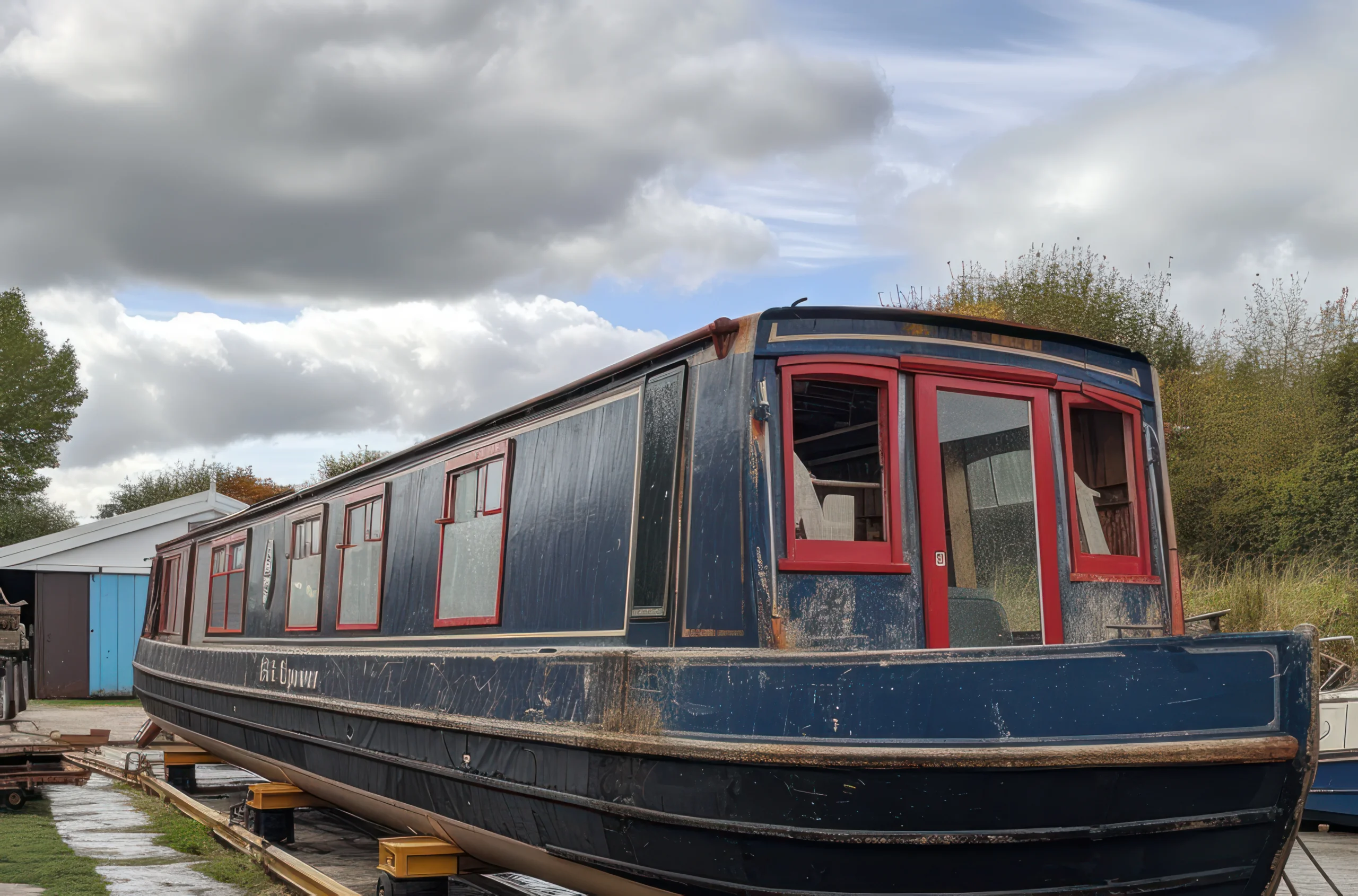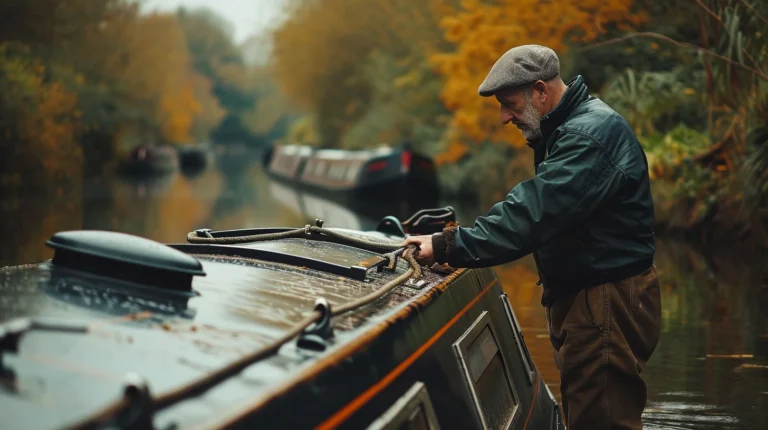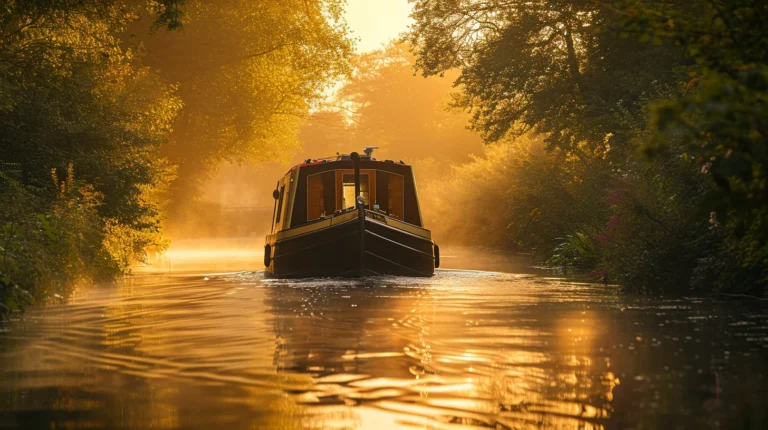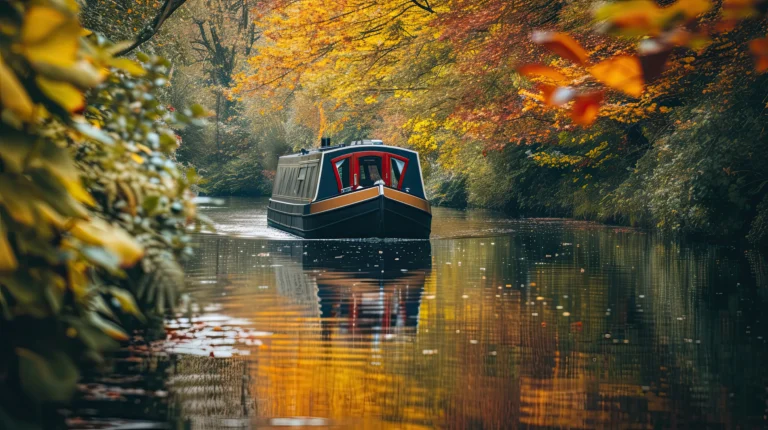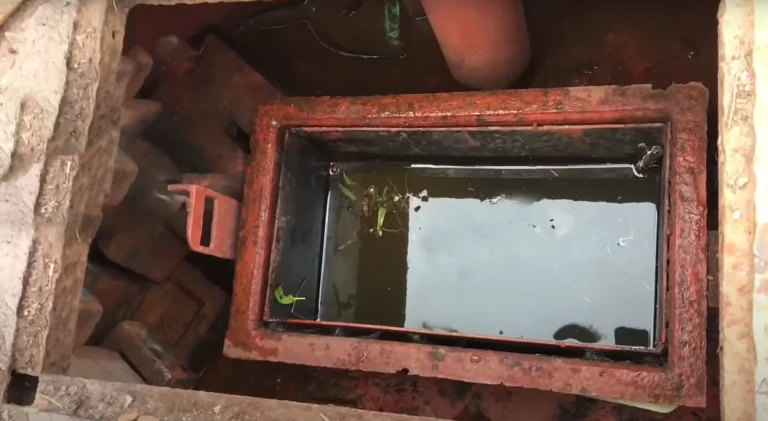How to Black a Narrowboat Hull: Preparation and Application
Blacking the hull of a narrowboat is crucial for its maintenance and protection from rust. Regular blacking not only helps preserve the hull’s condition but also has an impact on insurance costs.
Here’s the quick answer – To black a narrowboat hull: Lift boat from water and pressure wash hull. Let dry. Remove rust with wire brush. Apply rust inhibitor. Apply two coats of bitumen-based blacking, ensuring complete coverage. Let each coat dry before applying next. Return boat to water after final coat is fully dry.
Read on for more information.
In this article, we will explore the process of blacking a narrowboat hull, from preparation to choosing the right coating. So, if you are a narrowboat owner looking to keep your vessel in top shape, read on for valuable tips and insights.
Key Takeaways:
- Regularly blacking the narrowboat hull is essential for maintenance and rust prevention.
- Preparing the boat for blacking involves removing it from the water.
- There are different methods to remove the boat from the water, including craning and using a slipway trailer or dry dock.
- Two main types of blacking coatings are Bituminous blacking and Two Pack Epoxy blacking, each with their own advantages.
- Blacking can vary in cost depending on factors such as location, coating type, and boat size.
Methods to Remove the Boat from Water
When it comes to blacking a narrowboat hull, the first step is to remove the boat from the water. There are three common methods for accomplishing this: craning, using a slipway trailer, and utilizing a dry dock.
- Craning: This method involves using a large crane to lift the boat out of the water. While craning provides a quick and efficient way of removing the boat, it can be quite expensive.
- Slipway Trailer: A slipway trailer is the most cost-effective option for removing a narrowboat from the water. The boat is driven onto the trailer, which is then pulled out of the water using a vehicle or winch.
- Dry Dock: Utilising a dry dock involves driving the boat into a floating dock and then pumping out the water. This method provides a stable platform for working on the hull. Most people have this sort of hull work carried out in a dry dock.
The choice of method depends on various factors, such as cost, availability, and the specific requirements of the boat owner. While craning may be suitable for those with larger budgets and access to crane facilities, using a slipway trailer or dry dock can be more practical and affordable options for many narrowboat owners.
Some dry docks can also be rented so that DIY maintenance can be carried out by the boat owner. An expert at Portland Basin Marina explains:
“The dry dock is now fully operational and available for hire. It is a covered facility for all weather repairs. It is available for DIY or we can carry out hull blacking or repairs for you.”
Portland Basin Marina
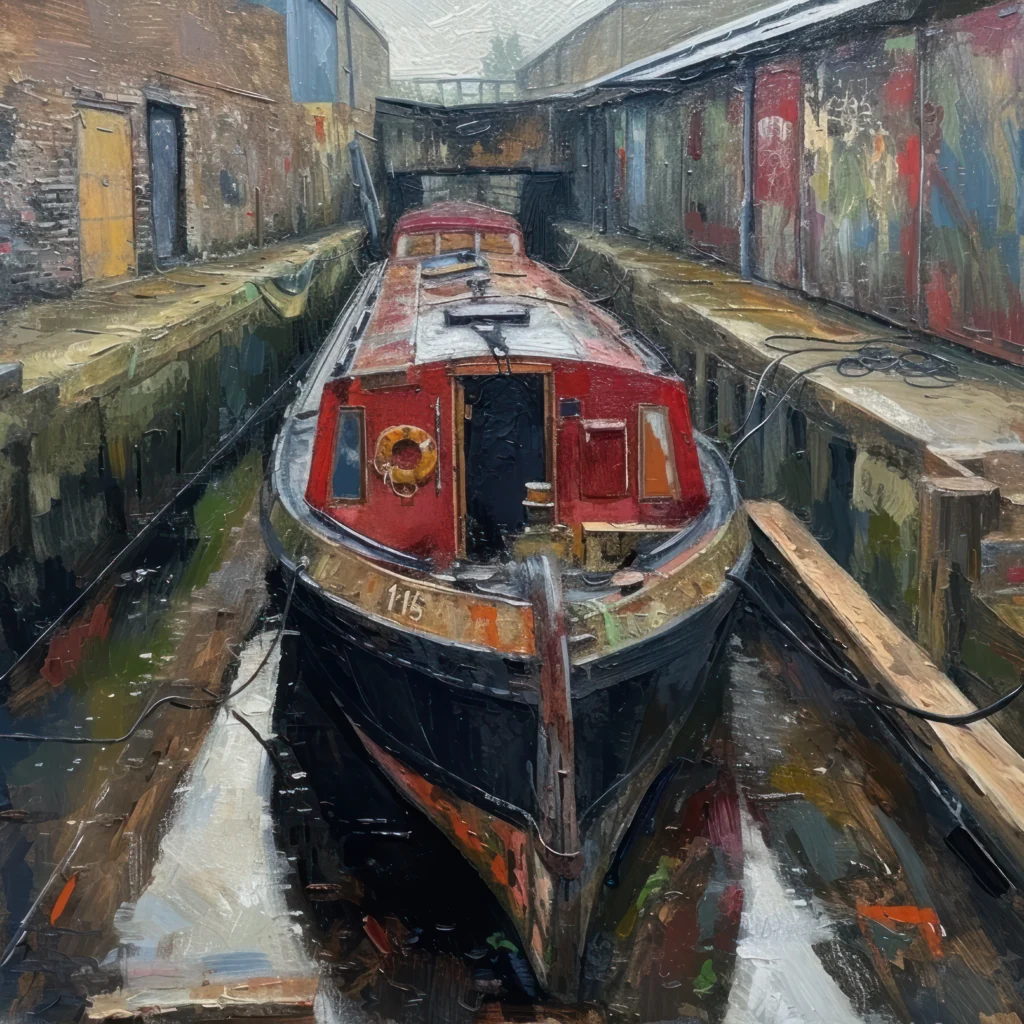
Types of Blacking Coatings
When it comes to blacking narrowboat hulls, there are two main types of coatings to consider: Bituminous blacking and Two Pack Epoxy blacking. Each option has its own advantages and considerations, allowing narrowboat owners to choose the best coating for their specific needs.
Bituminous blacking is a popular choice due to its affordability. It is a traditional coating that provides effective protection against rust and corrosion. However, it typically requires more frequent application, lasting around 2-3 years before needing to be reapplied.
Two Pack Epoxy blacking is a more advanced and durable option. While it comes with a higher price tag, it offers superior protection and longevity, lasting around 5-6 years before requiring reapplication. This type of blacking is particularly beneficial for narrowboats that spend a significant amount of time in abrasive or brackish water conditions.
If a narrowboat is already coated with Bituminous blacking and the owner decides to switch to Two Pack Epoxy, it’s important to note that the hull will need to be stripped back to bare steel. This process can be more labour-intensive and costly, but it ensures proper adhesion and the best results with the new coating. I’d always advise the epoxy method if you can afford it – especially if you have no intentions of selling the boat in the next few years.
The Benefits of Bituminous Blacking:
- Cost-effective option.
- Effective protection against rust and corrosion.
The Benefits of Two Pack Epoxy Blacking:
- Long-lasting protection (5-6 years).
- Superior durability, ideal for abrasive or brackish water conditions.
| Coating Type | Duration |
|---|---|
| Bituminous blacking | 2-3 years |
| Two Pack Epoxy blacking | 5-6 years |
Cost of Blacking the Hull of a Narrowboat
The cost of blacking a narrowboat hull can vary depending on several factors. These factors include the location of the boat, the type of coating chosen, and the size of the boat. As a result, the cost of blacking can range from as low as £800 to over £1,500.
It is always a good idea to shop around and compare prices from different providers to ensure you are getting the best value for your money. Keep in mind that while it is technically possible to undertake the blacking process yourself, it is generally recommended to hire professionals, especially if you are inexperienced in the process. This can help ensure a high-quality finish and minimize the risk of mistakes or damage to the hull.
Duration of the Hull Blacking Process
The process of blacking a narrowboat hull typically takes three days to complete. It involves several steps to ensure a thorough and effective coating that protects the hull from rust and damage. Here is an overview of the blacking duration and the tasks involved:
Day 1: Removal and Preparation
On the first day, the boat is removed from the water using one of the common methods such as craning, slipway trailer, or dry dock. Once out of the water, the hull is thoroughly pressure washed to remove any debris, rust, and the previous blacking coating. This step is essential to create a clean and smooth surface for the new coating.
Days 2 and 3: Coating Application
On the second and third days, the new blacking coating is applied to the hull. This is done by hand using a roller to ensure an even and comprehensive coverage. The choice of coating, whether bituminous blacking or two pack epoxy blacking, depends on factors such as budget and duration of protection desired. The coating is carefully applied to every inch of the hull, including hard-to-reach areas.
48 Hours Drying Time
After the coating has been applied, it is crucial to allow the hull to dry for a minimum of 48 hours. This drying time ensures that the coating sets properly and provides optimal protection against rust and corrosion. It is important to resist the temptation to rush the process and return the boat to the water before the recommended drying period.
By following this three-day blacking process, narrowboat owners can ensure that their boat’s hull is well-protected and maintained for years to come. The effort put into this essential maintenance task is well worth it to preserve the integrity and appearance of the narrowboat.
Maintaining the Boat Hull Coating After Blacking
Once the narrowboat hull has been blacked, proper maintenance is crucial to ensure its long-term protection and overall care. By following a few key practices, narrowboat owners can keep their hulls in excellent condition and avoid costly repairs.
Careful Cruising
One of the most important aspects of hull maintenance is practicing careful cruising. This means avoiding actions that can damage the hull, such as breaking through ice or crashing into banks and locks. By navigating with caution and being mindful of potential hazards, owners can prevent unnecessary wear and tear on their narrowboat hull.
Regular Inspection of Sacrificial Anodes
Sacrificial anodes play a crucial role in protecting the narrowboat hull against corrosion. These specially designed metallic devices sacrifice themselves by corroding instead of the hull. Regularly inspecting the sacrificial anodes is essential to ensure they are in good working condition. Look for signs of pitting and corrosion, as these indicate that the anodes are actively protecting the hull. If any issues are detected, replace the anodes promptly to maintain effective corrosion protection.
| Anode Type | Expected Lifespan | Price Range (per anode) |
|---|---|---|
| Zinc Anodes | 1-2 years | £10-£30 |
| Aluminium Anodes | 3-4 years | £15-£40 |
| Magnesium Anodes | 5-7 years | £20-£50 |
Table: Different Types of Sacrificial Anodes for Narrowboat Hulls (Price based on average price per anode.)
Regular Maintenance Checks
In addition to inspecting sacrificial anodes, regular maintenance checks should be conducted to keep the narrowboat hull in optimal condition. This includes examining the hull for signs of damage, such as scratches or dents, and promptly addressing any issues. It is also important to perform routine cleaning to remove dirt, algae, and other debris that can accumulate on the hull.
“Regularly checking the sacrificial anodes and conducting maintenance checks can go a long way in preserving the integrity of the narrowboat hull and preventing expensive repairs in the future.” – Mark Thompson, Narrowboat Owner
By following these maintenance practices, narrowboat owners can enjoy their vessels for many years to come. Taking proper care of the hull after blacking ensures its longevity and can save significant costs down the line.
Expert Tips and Feedback
When it comes to blacking a narrowboat hull, nothing beats the insights and advice of experts and fellow boat owners who have hands-on experience. Their tips and feedback can provide valuable guidance to ensure a successful blacking process and effective maintenance of your narrowboat.
Here are some expert tips and feedback to consider:
- Preparation is key: Before starting the blacking process, make sure to thoroughly clean the hull and remove any debris or old blacking. This will ensure proper adhesion of the new coating.
- Choose the right coating: Deciding on the type of blacking coating is crucial. Bituminous blacking is cost-effective but requires more frequent reapplication, while Two Pack Epoxy provides longer-lasting protection. Consider your budget and long-term maintenance goals when making this choice.
- Invest in quality products: Using high-quality blacking products can make a significant difference in the durability and appearance of your narrowboat hull. Look for trusted brands and consult with experts for recommendations.
- Don’t neglect the sacrificial anodes: Properly maintaining sacrificial anodes is essential for protecting your hull against corrosion. Regularly check them for signs of wear and replace them when necessary.
- Engage with the narrowboat community: Joining online forums, attending boat shows, and participating in narrowboat-related events are great ways to connect with experienced boaters. You can learn from their mistakes, gain valuable insights, and receive personalised advice for all your boat projects.
“I highly recommend switching to Two Pack Epoxy if you want long-lasting protection. It’s a bit pricier upfront, but you’ll save money in the long run with fewer recoating sessions.” – Sarah, narrowboat owner.
By following these expert tips and seeking feedback from the narrowboat community, you can ensure a successful blacking process and maintain your narrowboat hull in excellent condition for years to come.
Conclusion
Properly blacking a narrowboat hull is necessary for its maintenance and protection. By following the correct process and choosing the right coating, narrowboat owners can achieve lasting results. Regular maintenance, careful cruising, and the use of specialised boat care products are key to prolonging the life of the hull and avoiding expensive repairs.
By blacking the hull, narrowboat owners can ensure that their boats, and in many cases, homes, remain in top condition for years to come. The preparation, application, and maintenance of the hull are all vital aspects of narrowboat ownership. It is recommended to seek professional help in this process, especially for those who are new to maintaining a narrowboat.
Investing time and effort into narrowboat hull care will not only extend the boat’s lifespan but also enhance its overall appearance. By taking these steps, narrowboat owners can enjoy their journeys along the waterways, knowing that they have taken the necessary measures to protect and maintain their valuable asset.
Narrowboat Blacking Frequently Asked Questions
Q: What is the process of hull blacking for a narrowboat?
A: Hull blacking is a crucial part of narrowboat maintenance. It involves applying a protective coating to the bottom section of the boat to prevent corrosion and damage from the water.
Q: What are the types of coatings used to black the hull of a narrowboat?
A: The most common types of coatings used for hull blacking are bituminous and two-pack epoxy paints. These coatings provide effective protection against water and can last for several years once applied.
Q: How often does the coating used for hull blacking last?
A: Generally, a bitumen-finished coating will last around 2 to 6 years once applied, depending on the type of coating and the environmental conditions the boat is exposed to.
Q: What is the dry dock process for hull blacking?
A: During the dry dock process, the narrowboat is put onto a trailer, and a tractor pulls the boat out of the water. This allows for easy access to the hull for the blacking process.
Q: Can hull blacking be done without using a dry dock?
A: Yes, it is possible to undertake hull blacking without using a dry dock. This can be achieved by craning the boat out of the water or using a slipway for access to the hull.
Q: What are the essential steps for DIY hull blacking?
A: DIY hull blacking involves cleaning the hull, applying the chosen coating, and ensuring proper drying time. It is crucial to follow the manufacturer’s guidelines for the specific coating being used.
Q: Why is hull blacking considered an essential part of owning a narrowboat?
A: Owning a narrowboat means taking care of various maintenance jobs, and blacking is among one of the crucial tasks. It helps to protect the boat’s hull from corrosion and damage caused by being in water.
Q: What are the advantages of using epoxy paint for hull blacking?
A: Epoxy paint offers excellent adhesion and durability, providing long-term protection for the narrowboat’s hull. It is also resistant to abrasion, chemicals, and moisture, making it an effective choice for hull blacking.
Q: How often should I black my narrowboat hull?
A: The blacking should be applied every 2-6 years, depending on the type of coating used and the conditions the boat is exposed to.
Q: What is the water line when blacking a narrowboat?
A: The water line is the level where the water meets the boat’s hull and is the point to which the blacking should be applied.
Q: Can I apply the blacking coating myself?
A: Yes, blacking a narrowboat hull can be a DIY project, but it requires careful preparation, application, and adherence to safety and environmental guidelines.
Q: What are the considerations for applying blacking to a narrowboat hull?
A: When blacking your narrowboat hull, consider the boat’s water line, the type of coating to be used, the methods of application, and the frequency of future maintenance.
Q: What should be done before applying blacking to a narrowboat hull?
A: Before blacking a narrowboat hull, it’s important to prepare the surface by removing old coatings, cleaning, and inspecting for any damage or corrosion that needs to be addressed.
Q: Can two-pack epoxy be applied over bitumen as a blacking coating?
A: It’s generally not recommended to put two-pack epoxy over bitumen once the bitumen has fully dried as the new coating might not adhere properly. It’s important to follow proper instructions for compatibility and application.
Thanks for reading! We hope it helped! Please remember to visit our shop before you leave – we have narrowboat and canal mugs, clothing and lots more!

